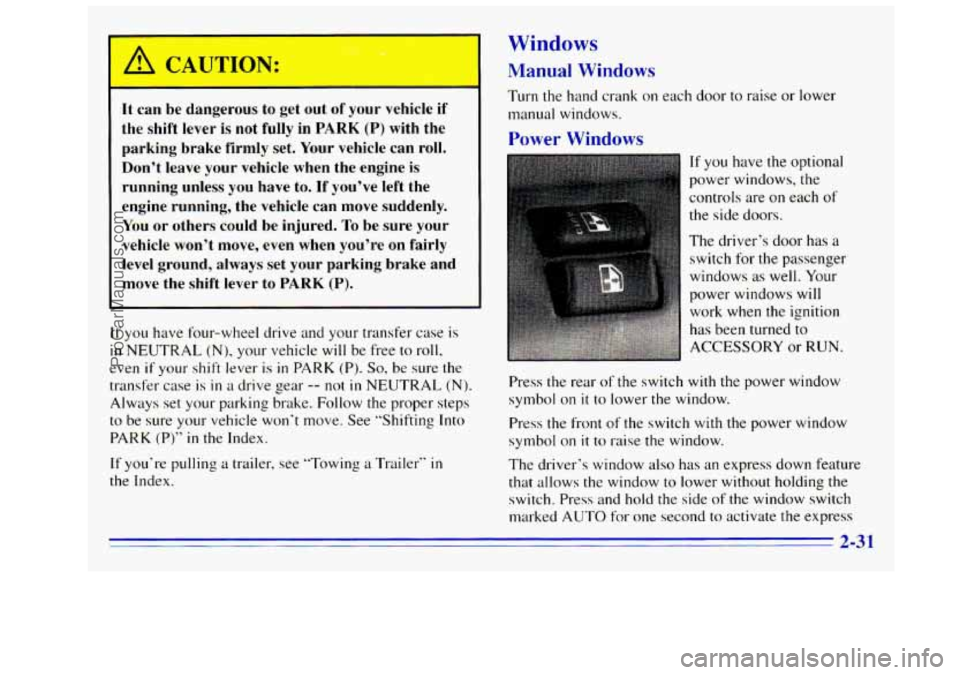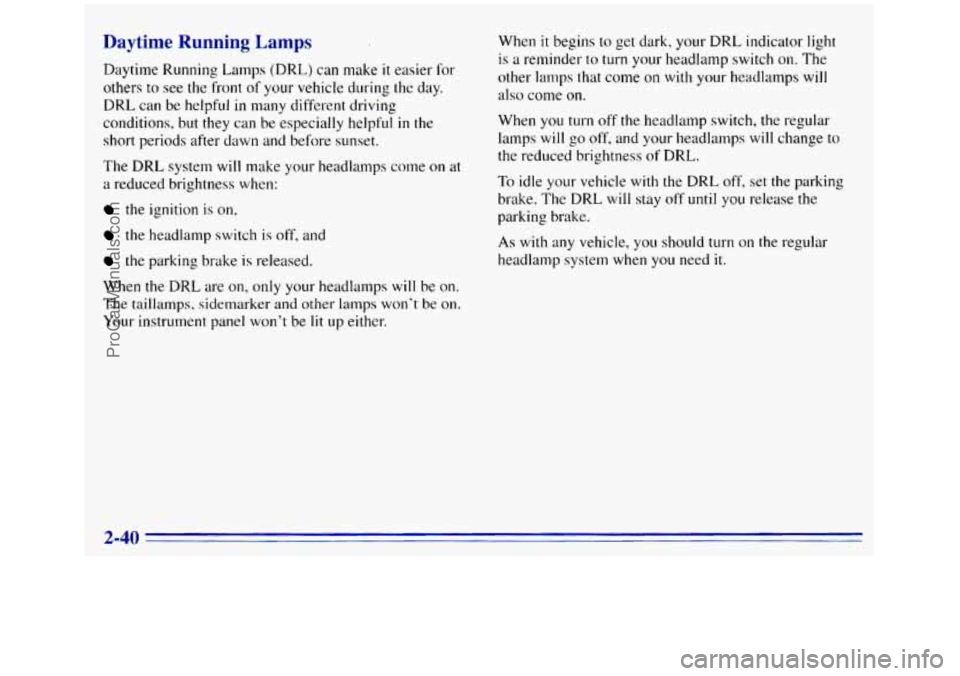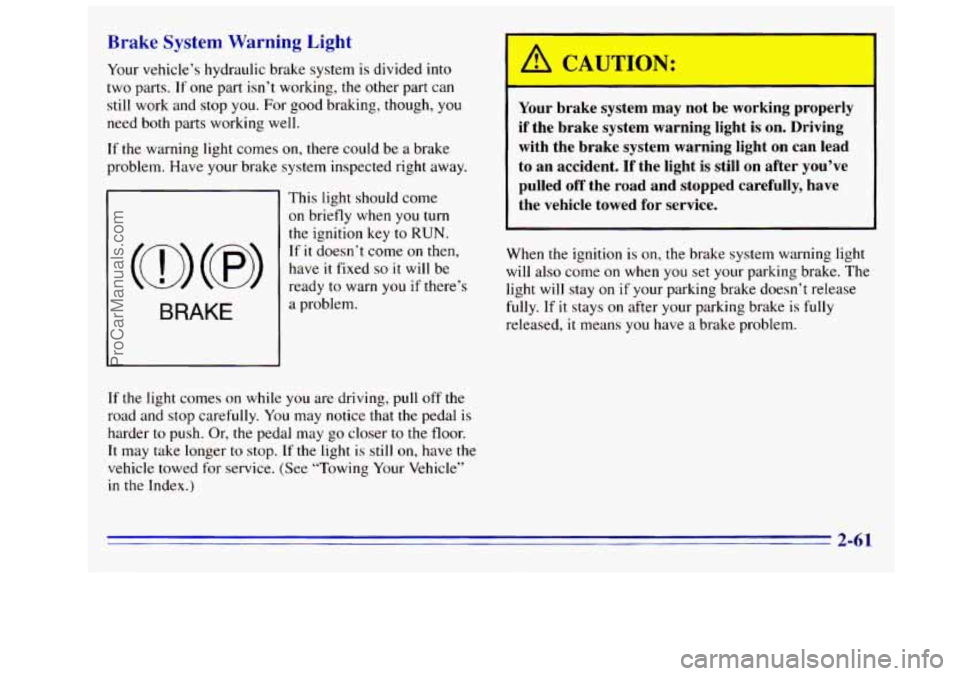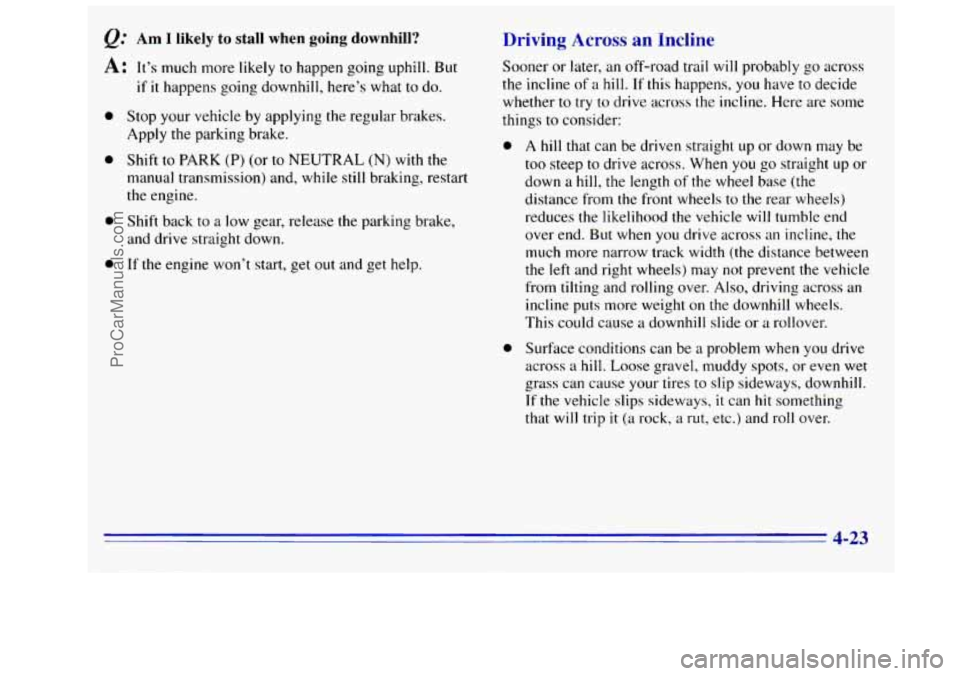Page 91 of 404
Parking Your Vehicle (Manual
Transmission Models Only)
Before you get out of your vehicle, put your manual
transmission in REVERSE (R), turn
off the engine, and
firmly apply the parking brake.
If you have four-wheel drive, be sure your transfer case
is in
a drive gear. Your vehicle could roll if it isn’t.
If you are parking
on a hill, or if you are pulling a
trailer, see “Towing a Trailer” in the Index.
Parking Over Things That Burn
f
A CAUTION:
Things that can burn could touch hot exhaust
parts under your vehicle and ignite. Don’t park
over papers, leaves, dry grass or other things that
can burn.
2-29
ProCarManuals.com
Page 93 of 404

CAUTION:
.*. .
It can be dangerous to get out of your vehicle if
the shift lever is not fully in
PARK (P) with the
parking brake firmly set. Your vehicle can roll.
Don’t leave your vehicle when the engine
is
running unless you have to. If you’ve left the
engine running, the vehicle can move suddenly.
You or others could be injured.
To be sure your
vehicle won’t move, even when you’re on
fairly
level ground, always set your parking brake and
move the shift lever to PARK (P).
If you have four-wheel drive and your transfer case is
in NEUTRAL (N), your vehicle will be free to roll,
even
if your shift lever is in PARK (P). So, be sure the
transfer case is
in a drive gear -- not in NEUTRAL (N).
Always set your parking brake. Follow the proper steps
, See “Shifting Into to be sure your vehicle won’t move
PARK
(P)“ in the Index.
If you‘re pulling a trailer. see “Tow
the Index. ing
a Trailer“
in
Windows
Manual Windows
Turn the hand crank on each door to raise or lower
manual windows.
Power Windows
If you have the optional
power windows, the
controls are
on each of
the side doors.
The driver’s door has a
switch for the passenger
windows as well. Your
power windows will
work when the ignition
has been turned to
ACCESSORY or
RUN.
Press the rear of the switch with the power window
symbol on
it to lower the window.
Press the front of the switch with the power window
symbol on
it to raise the window.
The driver’s window also
has an express down feature
that allows the window to lower without holding the
switch. Press and hold the side
of the window switch
marked AUTO for one second to activate the express
2-3 1
ProCarManuals.com
Page 102 of 404

Daytime Running Lamps
Daytime Running Lamps (DRL) can make it easier for
others to see the front of your vehicle during the day.
DRL can be helpful in many different driving
conditions, but they can be especially helpful
in the
short periods after dawn and before sunset.
The
DRL system will make your headlamps come on at
a reduced brightness when:
the ignition is on,
the headlamp switch is off, and
the parking brake is released.
When the
DRL are on, only your headlamps will be on.
The taillamps, sidemarker and other lamps won’t be on.
Your instrument panel won’t be lit up either. When
it begins to get dark, your DRL indicator light
is a
reminder to turn your headlamp switch on. The
other lamps that
come on with your headlamps will
also come on.
When you turn off the headlamp switch, the regular
lamps will go off, and your headlamps
will change to
the reduced brightness of DRL.
To idle your vehicle with the DRL off, set the parking
brake.
The DRL will stay off until you release the
parking brake.
As with any vehicle, you should turn on the regular
headlamp system when
you need it.
2-40
ProCarManuals.com
Page 117 of 404
A. Dome Lamp Switch
B. Lamp Controls
C.
Air Outlets
D. Multifunction Lever
E. Instrument Cluster
E Gearshift Lever
G. Audio System
H. Comfort Control System
I. Glove Box
J. Storage Tray
K. Ashtray
L. Cupholder
M. Auxiliary Power Outlets
N. Storage Area or Compact Disc Player (Option)
0. Rear Window Defogger Switch (Option)
P. Tilt Lever (Option)
Q. Parking Brake Release
R. Hood Release
S. Fuse Block
2-55
ProCarManuals.com
Page 123 of 404

Brake System Warning Light r
Your vehicle’s hydraulic brake system is divided into
two
parts. If one part isn’t working, the other part can
still work and stop you. For good braking, though, you
need both parts working well.
If the warning light comes on, there could be a brake
problem. Have your brake system inspected right away.
BRAKE
This light should come
on briefly when
you turn
the ignition key to
RUN.
If it doesn’t come on then,
have
it fixed so it will be
ready to
warn you if there’s
a problem.
If the light comes on while you are driving, pull off the
road and stop carefully. You may notice that the pedal is
harder to push. Or, the pedal may go closer to the floor.
It may take longer to stop. If
the light is still on, have the
vehicle towed for service. (See “Towing Your Vehicle”
in the Index.)
I! CAUTION:
Your brake system may not be working properly
if the brake system warning light is on. Driving
with the brake system warning light on can lead
to an accident. If the light
is still on after you’ve
pulled
off the road and stopped carefully, have
the vehicle towed for service.
When the ignition is on, the brake system warning light
will also come on when you set your parking brake. The
light will stay on if your parking brake doesn’t release
fully.
If it stays on after your parking brake is fully
released,
it means you have a brake problem.
2-61
ProCarManuals.com
Page 174 of 404

What should I do if my vehicle stalls, or is about
to stall, and
I can’t make it up the hill?
A: If this happens, there are some things you should
do, and these are some things you
must not do.
First, here’s what you shalrlcl do:
Push the brake pedal to stop the vehicle and
keep it from rolling backwards. Also, apply the
parking brake.
If your engine is still running, shift the transmission
to REVERSE
(R), release the parking brake, and
slowly back down the
hill in REVERSE (R).
If your engine has stopped running, you’ll need to
restart
it. With the brake pedal depressed and the
parking brake still applied, shift the transmission to
PARK (P) (or, shift to NEUTRAL (N) if your
vehicle has
a manual transmission) and restart the
engine. Then,
shift to REVERSE (R), release the
parking brake, and slowly back down the
hill as
straight as possible
in REVERSE (R).
As you are backing down the hill, put your left hand
on the steering wheel at the 12 o’clock position. This
way, you’ll be able to tell
if your wheels are straight
and maneuver as you back down.
It’s best that you
back down the
hill with your wheels straight rather
than
in the left or right direction. Turning the wheel
too far to the left or right will increase the possibility
of a rollover.
Here are sonie things you
rnusf not do if you stall, or are
about to stall, when going
up a hill.
Never attempt to prevent a stall by shifting into
NEUTRAL
(N) (or depressing the clutch, if you
have a manual transmission) to “rev-up” the engine
and regain forward momentum. This won’t work.
Your vehicle will roll backwards very quickly and
you could go out
of control.
Instead, apply the regular brake to stop the vehicle. Then
apply the parking brake. Shift to REVERSE
(R), release
the parking brake, and slowly back straight down.
Never attempt to turn around if you are about to stall
when going
up a hill. If the hill is steep enough to
stall your vehicle, it’s steep enough to cause you to
roll over if you turn around. If you can’t make it up
the
hill, you must back straight down the hill.
4-20
ProCarManuals.com
Page 175 of 404

&.’ Suppose, after stalling, I try to back down
the hill and decide
I just can’t do it. What
should 1 do?
A: Set the parking brake. put your transmission
in PARK (Pj (or the manual transmission in
FIRST ( I )) and turn off the engine. Leave the
vehicle
and go get some help. Exit on the uphill
side and stay clear
of the path the vehicle would
take if it rolled downhill. Do not shift the transfer
case to
NEUTRAL (N) when you leave the vehicle.
Leave
it in some gear. Shirring the
transter ca-- to NEU 1 dAL (N) can
cause your vehicle to roll even if the transmission
is in PARK (P) (or, if you have the manual
transmission, even if you’re in gear). This
is
because the NEUTRAL (N) position on the
transfer case overrides the transmission. If you
are going to
leave your vehicle, set the parking
brake and shift the transmission to
PARK (P)
(or, put your manual transmission in FIRST (I)).
But do not shift the transfer case to the
NEUTRAL (N) position. Leave the transfer
case in the
2 Wheel, 4 High or 4 I,ow position.
ProCarManuals.com
Page 177 of 404

Am I likely to stall when going downhill?
A: It’s much more likely to happen going uphill. But
0
e
a
0
if it happens going downhill, here’s what to do.
Stop your vehicle by applying the regular brakes.
Apply
the parking brake.
Shift
to PARK (P) (or to NEUTRAL (N) with the
manual transmission) and, while still braking, restart
the engine.
Shift back
to a low gear, release the parking brake,
and drive straight down.
If the engine won’t start, get out and get help.
Driving Across an Incline
Sooner or later, an off-road trail will probably go across
the
incline of a hill. If this happens, you have to decide
whether to try
to drive across the incline. Here are some
things
to consider:
0 A hill that can be driven straight up or down may be
too steep
to drive across. When you go straight up or
down a
hill, the length of the wheel base (the
distance from
the front wheels to the rear wheels)
reduces the likelihood the vehicle will tumble end
over end.
But when you drive across an incline, the
much more narrow track width (the distance between
the
left and right wheels) may not prevent the vehicle
from tilting and rolling over. Also, driving across an
incline puts more weight
on the downhill wheels.
This could cause
a downhill slide or a rollover.
0 Surface conditions can be a problem when you drive
across a
hill. Loose gravel, muddy spots, or even wet
grass can cause your tires to slip sideways, downhill.
If the vehicle slips sideways, it can hit something
that will trip it
(a rock, a rut, etc.) and roll over.
4-23
ProCarManuals.com